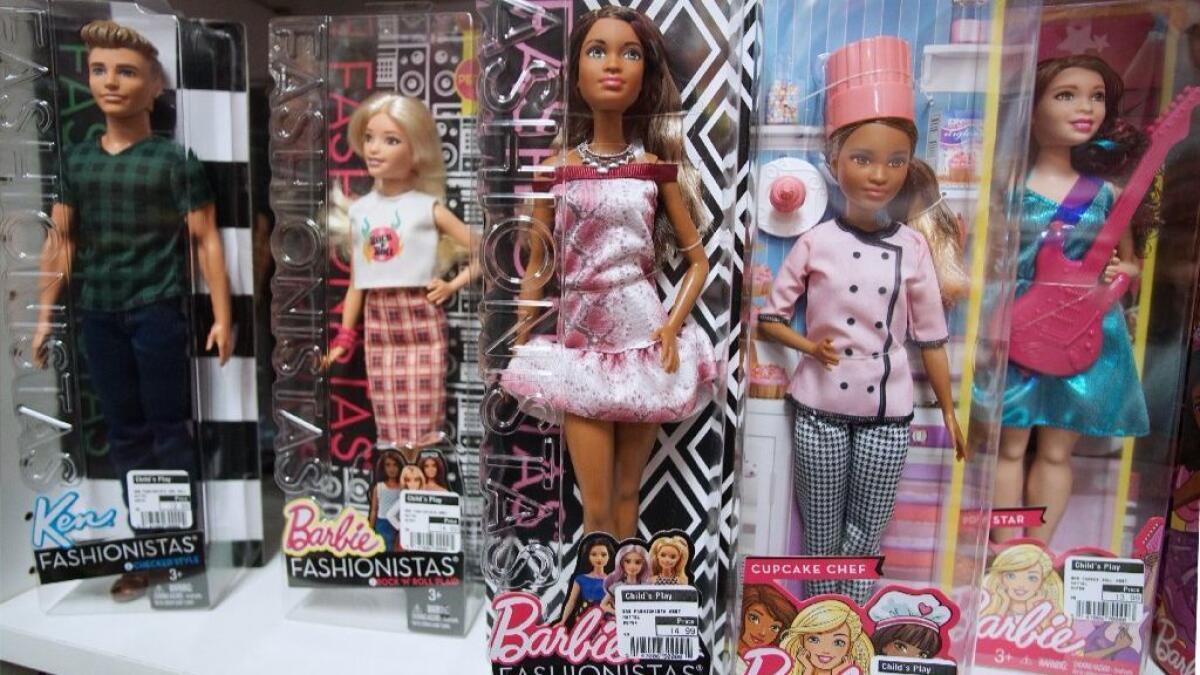Mattel posts a loss, and its years-long slump could deepen with Toys R Us closures

Denny Hamlin, a top driver in NASCAR racing, recently celebrated his daughter’s fifth birthday by having a pink limousine take her and her friends to an American Girl store in Charlotte, N.C., where they picked out their favorite dolls.
If only Mattel Inc. — which owns American Girl, the iconic Barbie line of dolls and other popular toy brands — could spark that level of interest among more parents and kids.
The El Segundo toy giant has suffered a steady drop in sales and profit in recent years, and the situation deteriorated even more than analysts had expected in the fourth quarter of 2017, which included the crucial holiday period, Mattel’s earnings report showed Thursday.
It might even get worse in the coming weeks.
Toys R Us Inc., which filed for bankruptcy reorganization in September, said last week that it will close about 180 of its U.S. retail stores this spring, including 13 in Southern California, which could further hurt Mattel, Hasbro Inc. and other toy makers. Toys R Us also plans to close at least 26 of its 105 stores in the United Kingdom.
Toys R Us accounts for 15% to 20% of Mattel’s U.S. sales and 11% of its global sales, and the store closures could further curb Mattel’s growth if “shipments that would have gone to [Toys R Us] are not picked up by other retailers,” analyst Linda Bolton Weiser of the investment firm D.A. Davidson & Co. said in a note to clients.
In response to these pressures, Mattel is scaling back to bolster its profitability.
Under the guidance of Margo Georgiadis, a former Google executive who became Mattel’s chief executive a year ago, the company plans to narrow its focus to enhancing Barbie, American Girl and its other core brands while streamlining its operations and slashing costs to match its lower sales.
Mattel also wants to get new versions of toys to market faster and broaden its brands’ appeal by expanding their ties to digital formats and entertainment platforms that kids increasingly are embracing.
The company had warned in December that its fourth-quarter and full-year sales would be hurt because, in part, retailers such as Toys R Us already were tightly controlling how many toys they were buying from Mattel and others.
On Thursday, Mattel said Barbie sales rose 6% from a year earlier but sales of most of its other toy brands fell, dragging down total sales by 14% to $1.61 billion. (All figures are adjusted to exclude currency fluctuations.) Mattel’s other brands include American Girl, Fisher-Price, Hot Wheels and Matchbox cars.
Mattel reported a fourth-quarter loss of $281.3 million, compared with year-earlier profit of $173.8 million. The company also posted a per-share loss of 72 cents after adjustments for one-time items such as a charge related to the recently enacted tax reform.
Excluding the tax item, Mattel had an adjusted loss of 42 cents a share, compared with the 16-cent profit analysts had expected and Mattel’s adjusted profit of 52 cents a share a year earlier.
“Our fourth-quarter performance reflects a tough quarter as part of what was a difficult and extraordinary year for Mattel,” Georgiadis told analysts on a conference call. She said Mattel “faced multiple significant dislocations” that included “mixed brand performance and the TRU [Toys R Us] bankruptcy.”
But she added that with Mattel’s restructuring plan, “we are optimistic the business is on course to stabilize revenue in 2018 and, with the benefit of our significant cost-reduction program, we expect to improve profit trends in 2018.”
There are several other issues buffeting Mattel, including:
- Speculation that Hasbro will mount a takeover bid for Mattel has caused Mattel’s stock price to gyrate of late. Both companies repeatedly have declined to comment on the rumors, which have surfaced periodically for two decades.
- Mattel’s stock has tumbled 50% in the last 12 months, to $15.32 a share on Thursday from $31, partly reflecting Mattel’s decision to suspend its dividend in the fourth quarter of last year to lower costs. Mattel currently has a total market value of $5.5 billion.
- The toy industry overall is barely growing. Research firm NPD Group said that U.S. toy sales edged up 1% last year to $20.7 billion and that sales across 12 global markets it tracks also rose 1%.
- Mattel’s debt was downgraded by the major credit-rating firms in December, with Fitch Ratings analyst David Silverman citing problems such as Mattel’s “execution missteps, including the inability of the company to effectively respond to evolving play patterns.” Mattel has been “challenged by the phenomenon of children -- in particular, girls -- outgrowing traditional toys at a younger age, with greater interest in consumer electronics, beauty, sports and social media,” Silverman said.
- Mattel has struggled to replace the more than $400 million in annual sales of Disney Princess toys that were lost when Hasbro wrested the Disney Princess toy license from Mattel starting in 2016.
- There has been a slowdown in sales of toys tied to major motion pictures. Even so, Hasbro has remained stronger than Mattel partly due to Hasbro’s license of the popular “Star Wars” franchise, said Keith Snyder of CFRA Research.
“Toy sales these days have shifted toward branded products,” such as those tied to movies, and away from “the legacy brands like Barbie,” Snyder said. Mattel, he added, “sat on their brands too long and have been complacent with their market position” with “very little changes to Barbie and American Girl.”
In June, Mattel unveiled a “plan to reinvent” the company by expanding Barbie and its other “power brands” to create a “360-degree” experience that involves both playing with the toys physically and with related digital and entertainment platforms.
Mattel also said it would speed up its “innovation pipeline” by developing new products in six to nine months instead of 18 months. The company also launched plans to shed at least $650 million in operating costs over the next two years and it suspended its dividend.
Mattel is “working on shortening the product cycles and the red tape” at the company, which employs 32,000 people, Snyder said.
Georgiadis and other Mattel executives declined additional comment ahead of Thursday’s quarterly report. But the company said in a statement to The Times that its plan would “dramatically transform Mattel, repositioning the company to draw on our world-class brand portfolio.”
“We are making strong progress against this plan, which we believe will enable Mattel to deliver revenue growth and improved profitability,” the company said, adding that it’s also “strengthening our position in key markets like China, where consumer spending on toys is growing at a rapid rate.”
If Mattel were to sell itself to Hasbro before it fully implements that restructuring plan, some analysts aren’t persuaded it would be a good match.
“We remain torn on whether this is a good move for Hasbro,” analyst Stephanie Wissink of the investment firm Jefferies said in a recent note to clients. She said the idea was “tempting” but that if Mattel showed a willingness to sell now, it “also signals just how deep the issues run” at Mattel.
For now, with the overall toy market barely growing, the pressure is on Mattel to better exploit current trends to take market share from Hasbro and others if it hopes to get sales growing again.
“It is more imperative than ever to be able to react quickly to changing tastes and fast-moving trends,” Juli Lennett, NPD’s senior vice president and industry advisor for toys, said in a statement.
“Toy companies, whether they are big or small, who are nimble enough to react faster and get to market more quickly, are the ones who will win in the long term,” she said.
Silverman said Mattel’s revamp will take time.
“They want to be smaller, better, more streamlined, which are all certainly fantastic goals,” he said. “But given the trajectory that the business is on right now, that’s a lot to accomplish.”
Twitter: @PeltzLATimes
UPDATES:
2:45: This article was updated with comments from Mattel’s CEO Georgiadis to analysts Thursday.
2:15 p.m.: This article was updated with details from Mattel’s fourth-quarter report Thursday.
This article was originally published at 5:20 p.m. on Jan. 31, 2018
More to Read
Inside the business of entertainment
The Wide Shot brings you news, analysis and insights on everything from streaming wars to production — and what it all means for the future.
You may occasionally receive promotional content from the Los Angeles Times.











